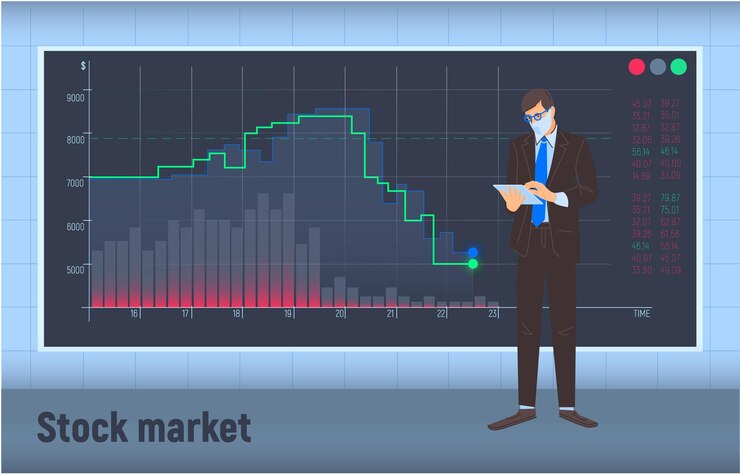Introduction
The Stock Market Predictions, a complex ecosystem of investments and speculations, has always fascinated and intimidated investors alike. Predicting its movements is a tantalizing yet challenging endeavor, often likened to trying to catch a falling star. While absolute certainty is elusive, understanding the underlying factors and employing sound strategies can significantly enhance your investment decisions. This article aims to provide a comprehensive guide to stock market predictions, exploring various factors, techniques, and considerations to help you make informed choices.
Understanding the Stock Market
Before delving into predictions, it’s essential to grasp the basics of the Stock Market Predictions. A stock, or equity, represents ownership in a company. The value of a stock fluctuates based on factors such as the company’s performance, industry trends, economic conditions, and investor sentiment.

Key Factors Influencing Stock Prices
-
Economic Indicators:
- GDP: Gross Domestic Product measures a nation’s overall economic health. A growing GDP generally correlates with a rising stock market.
- Inflation: Rising inflation can erode purchasing power and lead to higher interest rates, potentially impacting stock prices negatively.
- Interest Rates: Lower interest rates tend to favor stock investments as they make borrowing cheaper and encourage spending.
-
Company Fundamentals:
- Earnings: A company’s profitability, as measured by earnings per share (EPS), is a crucial factor. Strong earnings often drive stock prices up.
- Revenue: A company’s revenue growth indicates its ability to generate sales and generate profits.
- Debt: High debt levels can pose risks to a company’s financial stability and may negatively impact its stock price.
-
Industry Trends:
- Market Disruptions: Technological advancements or industry disruptions can significantly affect stock prices. For example, the rise of e-commerce has challenged traditional retail businesses.
- Regulatory Changes: Government regulations can impact specific industries, leading to stock price fluctuations.
-
Global Events:
- Geopolitical Factors: Political instability, trade wars, or natural disasters can create uncertainty and influence stock market movements.
- Natural Disasters: Catastrophic events can disrupt supply chains, impact businesses, and cause market volatility.
Technical Analysis: Charting the Course
Technical analysis involves studying historical price data and patterns to identify potential future price movements. Key techniques include:
- Trend Lines: Identifying upward or downward trends to anticipate future price movements.
- Support and Resistance Levels: Identifying price levels where buying or selling pressure is likely to be strong.
- Chart Patterns: Recognizing recurring patterns such as head-and-shoulders, triangles, and double tops/bottoms.
- Indicators: Using mathematical formulas to analyze price data, such as moving averages, relative strength index (RSI), and stochastic oscillator.
Fundamental Analysis: Digging Deeper
Fundamental analysis focuses on evaluating a company’s underlying value based on its financial statements, industry trends, and competitive position. Key metrics include:
- Price-to-Earnings (P/E) Ratio: Compares a company’s stock price to its earnings per share.
- Price-to-Book (P/B) Ratio: Compares a company’s stock price to its book value.
- Return on Equity (ROE): Measures a company’s profitability relative to its shareholders’ equity.
Investing Strategies
- Diversification: Spreading investments across various asset classes and sectors to reduce risk.
- Dollar-Cost Averaging: Investing a fixed amount regularly, regardless of market conditions.
- Index Investing: Investing in index funds that track a broad market index, such as the S&P 500.
- Active Management: Selecting individual stocks or funds based on research and analysis.

Conclusion
Stock Market Predictions is an inherently challenging task, as numerous factors can influence price movements. While there are no foolproof methods, a combination of technical and fundamental analysis, coupled with sound investment strategies, can improve your chances of making informed decisions. Remember, investing involves risk, and it’s essential to set realistic expectations and have a long-term perspective.
FAQs
- Is it possible to accurately predict stock market movements?
- While absolute accuracy is difficult, understanding key factors and employing sound strategies can increase your chances of making informed decisions.
- Which is better, technical analysis or fundamental analysis?
- Both approaches have their merits. Technical analysis focuses on price patterns, while fundamental analysis evaluates a company’s underlying value. A combination of both can provide a more comprehensive view.
- Should I invest in individual stocks or index funds?
- The choice depends on your risk tolerance and investment goals. Index funds offer diversification and lower costs, while individual stocks can provide higher potential returns but also carry higher risks.
- How can I protect my investments from market volatility?
- Diversification, dollar-cost averaging, and investing in defensive sectors can help mitigate risk.
- What is the role of emotions in investing?
- Emotions can cloud judgment and lead to impulsive decisions. It’s important to maintain discipline and avoid making emotional investments.
